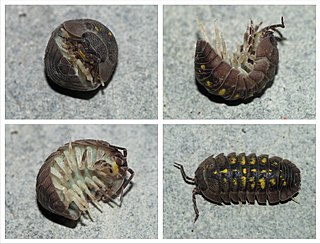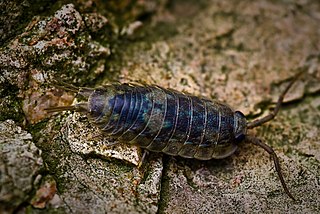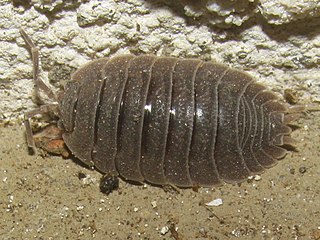
Fucus vesiculosus, known by the common names bladder wrack, black tang, rockweed, sea grapes, bladder fucus, sea oak, cut weed, dyers fucus, red fucus and rock wrack, is a seaweed found on the coasts of the North Sea, the western Baltic Sea and the Atlantic and Pacific Oceans. It was the original source of iodine, discovered in 1811, and was used extensively to treat goitre, a swelling of the thyroid gland related to iodine deficiency.

The white-beaked dolphin is a marine mammal belonging to the family Delphinidae in the suborder Odontoceti.

Isopoda is an order of crustaceans that includes woodlice and their relatives. Isopods live in the sea, in fresh water, or on land. All have rigid, segmented exoskeletons, two pairs of antennae, seven pairs of jointed limbs on the thorax, and five pairs of branching appendages on the abdomen that are used in respiration. Females brood their young in a pouch under their thorax.

Armadillidiidae is a family of woodlice, a terrestrial crustacean group in the order Isopoda. Unlike members of some other woodlice families, members of this family can roll into a ball, an ability they share with the outwardly similar but unrelated pill millipedes and other animals. This ability gives woodlice in this family their common names of pill bugs or roly polies. Other common names include slaters,potato bugs, doodle bugs and cheeselogs. Most species are native to the Mediterranean Basin, while a few species have wider European distributions. The best-known species, Armadillidium vulgare, was introduced to New England in the early 19th century and has become widespread throughout North America.

Pyrosomes, genus Pyrosoma, are free-floating colonial tunicates that usually live in the upper layers of the open ocean in warm seas, although some may be found at greater depths. Pyrosomes are cylindrical or cone-shaped colonies up to 18 m (60 ft) long, made up of hundreds to thousands of individuals, known as zooids. Colonies range in size from less than one centimeter to several metres in length. They are commonly called "sea pickles". Other nicknames include "sea worms", "sea squirts", "fire bodies", and "cockroaches of the sea".

The starlet sea anemone is a species of small sea anemone in the family Edwardsiidae native to the east coast of the United States, with introduced populations along the coast of southeast England and the west coast of the United States. Populations have also been located in Nova Scotia, Canada. This sea anemone is found in the shallow brackish water of coastal lagoons and salt marshes where its slender column is usually buried in the mud and its tentacles exposed. Its genome has been sequenced and it is cultivated in the laboratory as a model organism, but the IUCN has listed it as being a "Vulnerable species" in the wild.

Ligia oceanica, the sea slater, common sea slater, or sea roach, is a littoral zone woodlouse, living on rocky seashores of the European North Sea and Atlantic coastlines.

A woodlouse is an isopod crustacean from the polyphyletic suborder Oniscidea within the order Isopoda. They get their name from often being found in old wood.

Palaemon serratus, also called the common prawn, is a species of shrimp found in the Atlantic Ocean from Denmark to Mauritania, and in the Mediterranean Sea and Black Sea.

Idotea is a genus of isopod crustaceans, mostly from cold temperate waters. The taxonomy of the genus is still in doubt, and many of the currently recognised species may be taxonomic synonyms, and others may be moved to different genera.

Eurydice pulchra, the speckled sea louse, is a species of isopod crustacean found in the northeast Atlantic Ocean.

Like humans and other animals, fish suffer from diseases and parasites. Fish defences against disease are specific and non-specific. Non-specific defences include skin and scales, as well as the mucus layer secreted by the epidermis that traps microorganisms and inhibits their growth. If pathogens breach these defences, fish can develop inflammatory responses that increase the flow of blood to infected areas and deliver white blood cells that attempt to destroy the pathogens.

Naria turdus, common name : the thrush cowrie, is a species of sea snail, a cowry, a marine gastropod mollusk in the family Cypraeidae, the cowries.

Charonia variegata, the Atlantic triton or Atlantic triton's trumpet, is a species of predatory sea snail, a marine gastropod mollusk in the family Charoniidae, the triton snails, triton shells, or tritons.

Stellaria apetala, commonly known as lesser chickweed, is an annual herbaceous plant in the flowering plant family Caryophyllaceae. It is native to Europe and is an introduced species in North America.

Idotea balthica is a species of marine isopod which lives on seaweed and seagrass in the subtidal zone of rocky shores and sandy lagoons.
Idotea linearis is a species of elongated isopod crustacean.
Hemioniscus balani, a species of isopod crustacean, is a widespread parasitic castrator of barnacle in the northern Atlantic Ocean. Its range extends from Norway to the Atlantic coast of France, and as far west as Massachusetts. It is also commonly found on the Pacific coast of North America; it is not known if the Pacific and Atlantic populations are the same species, or if the Pacific population exists following human-assisted introduction.

Praunus flexuosus, known as the chameleon shrimp, is a species of opossum shrimp found in European waters. It reaches 26 mm (1.0 in) long, with a distinctly bent body, and closely resembles Praunus neglectus. It lives in shallow water and tolerates a wide range of salinities. It is found from northern France to the Baltic Sea, and was introduced to North America in the mid 20th century.

Porcellio dilatatus is a species of woodlouse in the genus Porcellio belonging to the family Porcellionidae. This species is widespread in Europe, and has also been introduced to North America from Western Europe. They are 15 millimetres (0.59 in) long, are brown coloured and striped. They can be found feeding on alder leaves, but mostly feeds on organic food substrates, such as lettuce in the wild. It also feeds on inorganic metal salts.















